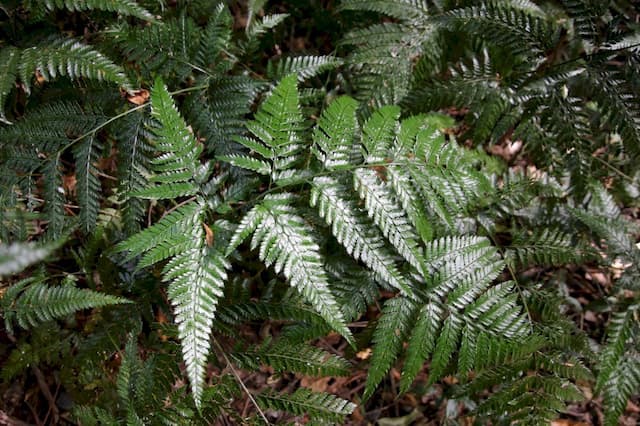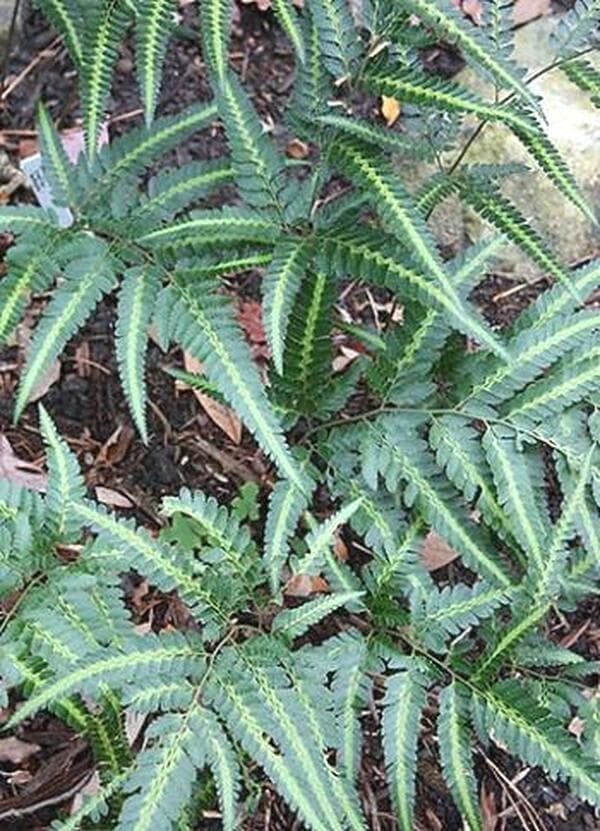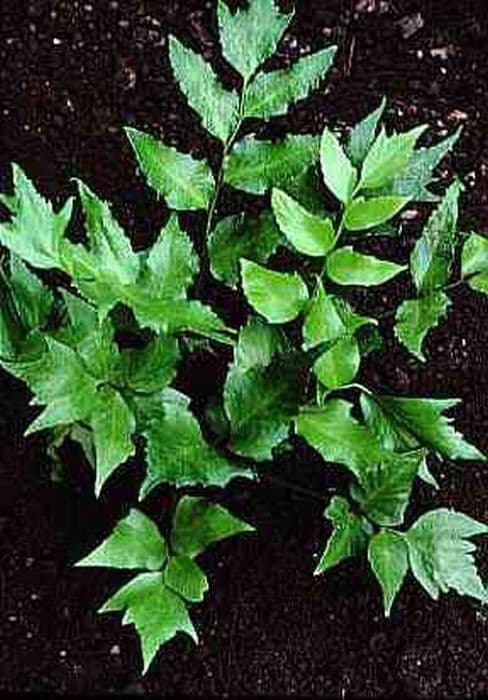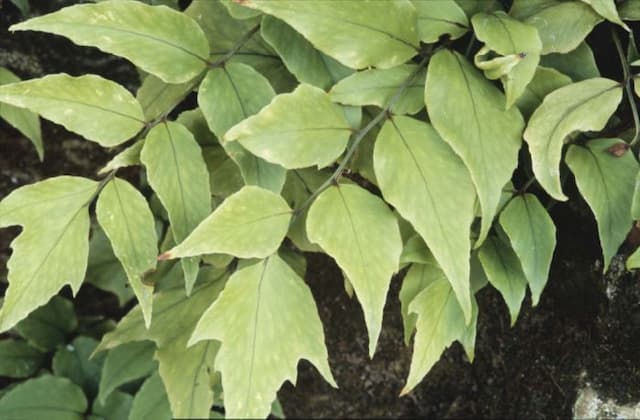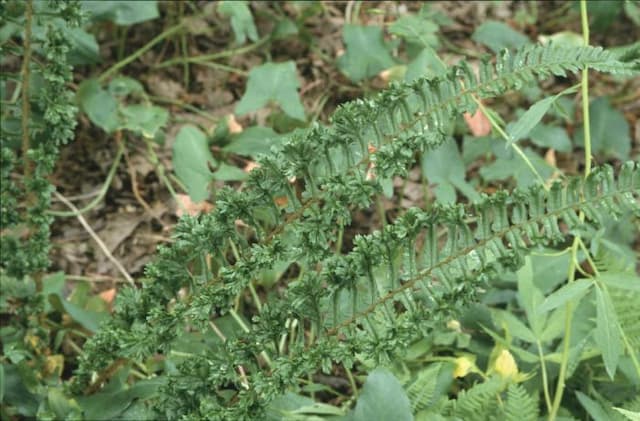Thick-stemmed wood fern Dryopteris crassirhizoma

ABOUT
The Dryopteris crassirhizoma, commonly known as Thick-stemmed Wood Fern, presents a robust and lush appearance, often found in shaded forested areas which offers it the cool, moist environment it favors. The plant is noted for its dense clumps of fronds that emanate from a central base. Each frond is divided into numerous leaflets giving the plant a feathery texture. The leaflets are generally triangular in outline, narrowing towards the tip with serrated or toothed edges adding a fine texture to the overall look of the frond. Their color ranges from a bright, fresh green to a deeper, richer hue, depending on the maturity of the fronds and the time of year. Young fronds often emerge with a slightly scaly texture, unfurling gracefully as they mature. The central stem of each frond is typically thicker and stronger, supporting the delicate structure of the leaflets. This robust central rachis contributes to the characteristic sturdiness and upright nature of the fern. The root system of the Thick-stemmed Wood Fern is substantial, enabling the plant to anchor itself firmly in the soil and absorb ample nutrients and moisture. In terms of its reproductive features, the undersides of the fronds bear sori, which are clusters of spore-producing organs. These sori are often covered by a protective tissue and may be visible as small, dot-like structures that dot the under surface of the leaflets, adding another element of texture and interest to the plant's appearance. While the leaves are the most noticeable part of the Thick-stemmed Wood Fern, its overall shape and structure play a significant role in its identification, with a graceful, arching habit that softens the landscape and adds a touch of elegance to its natural setting.
About this plant
 Names
NamesFamily
Dryopteridaceae
Synonyms
Thick-stemmed Wood Fern, Shield Fern
Common names
Dryopteris austriaca subsp. crassirhizoma, Dryopteris crassirhizoma var. nipponensis, Dryopteris crassirhizoma var. robusta, Dryopteris cycadina, Dryopteris varia subsp. crassirhizoma, Lastrea crassirhizoma.
 Toxicity
ToxicityTo humans
The plant Dryopteris crassirhizoma, commonly known as the thick-stemmed wood fern, is not typically considered highly toxic to humans. However, as with many ferns, it could contain mild toxins that could cause stomach upset or intestinal discomfort if ingested in large quantities. These could include symptoms such as nausea, vomiting, and diarrhea. It is generally advised to avoid consuming parts of this fern to prevent these potential adverse effects.
To pets
Similar to its effects on humans, the thick-stemmed wood fern (Dryopteris crassirhizoma) is not known to be highly toxic to pets. Nonetheless, if pets were to ingest a significant amount of the plant, they might experience mild gastrointestinal symptoms such as vomiting or diarrhea. It is always prudent to keep an eye on your pets around houseplants and to discourage them from chewing on plants that could potentially cause them harm.
 Characteristics
CharacteristicsLife cycle
Perennials
Foliage type
Deciduous
Color of leaves
Green
Height
2 feet (61 cm)
Spread
2 feet (61 cm)
Plant type
Fern
Hardiness zones
5
Native area
East Asia
Benefits
 General Benefits
General Benefits- Erosion Control - The plant's dense root system helps stabilize soil and prevent erosion in landscapes.
- Habitat for Wildlife - Dryopteris crassirhizoma provides a natural habitat and cover for small animals and insects.
- Aesthetic Appeal - With its lush green fronds, it adds visual interest and natural beauty to gardens and natural settings.
- Shade Tolerance - The plant can grow well in shady areas where other plants may not thrive, making it versatile for landscaping in different light conditions.
- Low Maintenance - It typically requires minimal care once established, making it a convenient choice for gardeners of all skill levels.
- Soil Enrichment - As the fronds decompose, they contribute organic matter to the soil, enhancing its structure and fertility.
 Medical Properties
Medical Properties- Antiparasitic: Used in traditional medicine to expel intestinal parasites such as worms.
- Antibacterial: Contains compounds that have been shown to inhibit the growth of certain bacteria.
- Anti-inflammatory: May have properties that reduce inflammation, which could help in the treatment of inflammatory conditions.
- Hemostatic: Utilized traditionally to control bleeding, acting as a styptic agent.
 Air-purifying Qualities
Air-purifying QualitiesThis plant is not specifically known for air purifying qualities.
 Other Uses
Other Uses- Dye Source: The roots of the Dryopteris crassirhizoma, commonly called wood fern, can be used to produce a natural dye for textiles, yielding various shades of color depending on the mordant used.
- Garden Ornamentation: Wood ferns are commonly used in shade gardens or woodland gardens for their ornamental foliage and to create naturalistic landscapes.
- Erosion Control: Due to their dense root systems, wood ferns can be effective at stabilizing soil and preventing erosion on slopes or in areas with loose soil.
- Floral Arrangements: The fronds of wood ferns are sometimes incorporated into floral arrangements for greenery and to add a feathery texture.
- Companion Planting: Wood ferns can be planted alongside other shade-loving perennials to create a diverse and healthy plant community that can combat pests and diseases more effectively.
- Craft Material: Fronds from wood ferns can be dried and used in various craft projects, such as making bookmarks or framing for decoration.
- Indicator of Soil Quality: The growth and health of wood ferns can serve as indicators of soil quality and pH balance in their growing environment.
- Biomonitoring: Wood ferns can accumulate certain elements from the soil, making them useful for biomonitoring and studying the presence of these elements in the environment.
- Habitat Creation: Planting wood ferns can help to recreate habitat for native insects and animals, particularly in areas where natural flora has been disturbed or removed.
- Natural Mulch: As the fronds of wood ferns die back, they create a natural mulch layer that can help retain soil moisture and suppress weeds around the base of the plant.
Interesting Facts
 Feng Shui
Feng ShuiThe plant commonly known as Wood Fern is not used in Feng Shui practice.
 Zodiac Sign Compitability
Zodiac Sign CompitabilityThe Wood Fern is not used in astrology practice.
 Plant Symbolism
Plant Symbolism- Endurance - Dryopteris crassirhizoma, commonly known as the Male Fern, typically symbolizes endurance because it can thrive in challenging environments and has a robust root system that allows it to survive in difficult conditions.
- Protection - The Male Fern is often associated with protection due to its traditional use in warding off evil spirits and as a natural deterrent for insects.
- Health and Healing - This fern has been used in traditional medicine, and as a result, is sometimes used to symbolize health and healing.
- Rebirth and New Beginnings - Ferns in general, including the Male Fern, are symbols of rebirth and new beginnings because they are one of the first plants to emerge in the spring.
- Secret Bond or Friendship - In Victorian times, ferns represented secret bonds of love or friendship, as they could be given as a covert sign of one's feelings.
 Water
WaterThe Thick-Stemmed Wood Fern should be watered deeply but infrequently, allowing the top inch of soil to dry out between waterings. It is typically sufficient to water this plant once every 7 to 10 days, depending on the humidity and temperature conditions of the environment. When watering, apply water at the base of the plant until it starts to run out of the drainage holes, which should be around half a gallon for a medium-sized pot. During the winter months or in particularly humid conditions, reduce the frequency to avoid waterlogging, which can lead to root rot.
 Light
LightThe Thick-Stemmed Wood Fern thrives in moderate to bright indirect light, but can also tolerate lower light levels making it suitable for a variety of indoor settings. Avoid placing the fern in direct sunlight as it can scorch the fronds. A spot near a north-facing window or a few feet away from a south or west-facing window will provide the ideal light conditions for this plant.
 Temperature
TemperatureThe Thick-Stemmed Wood Fern prefers temperatures between 60 and 75 degrees Fahrenheit for optimal growth. It can withstand a few degrees cooler, but temperatures should not drop below 50 degrees Fahrenheit as it may damage the plant. Likewise, prolonged exposure to temperatures above 80 degrees Fahrenheit can stress the fern, so it's important to provide a consistent environment that stays within this ideal temperature range.
 Pruning
PruningThe Thick-Stemmed Wood Fern benefits from occasional pruning to remove any dead or yellowing fronds, which not only improves the plant's appearance but also encourages healthier growth. Prune the fern in spring or early summer, which is when the plant is actively growing and can recover more readily from pruning. Remove the fronds at the base, using clean, sharp scissors or pruning shears, and be sure not to overprune, as this can stress the plant.
 Cleaning
CleaningAs needed
 Soil
SoilThe Thick-stemmed Wood Fern thrives best in a well-draining soil mix, rich in organic matter such as leaf mold or compost. The soil pH should be slightly acidic to neutral, ranging from 5.5 to 7.0. A mix of one part garden soil, one part peat, and one part perlite or coarse sand is ideal for ensuring proper drainage and a healthy root environment.
 Repotting
RepottingThe Thick-stemmed Wood Fern, known as Dryopteris crassirhizoma, should generally be repotted every 2-3 years. Repotting too often can be disruptive to the plant, but at the same interval, fresh soil and a slightly larger pot encourage healthy growth.
 Humidity & Misting
Humidity & MistingThe Thick-stemmed Wood Fern prefers high humidity levels, typically around 60-70%. It thrives in moist air but should not be kept in overly wet or soggy conditions, as this can lead to root rot.
 Suitable locations
Suitable locationsIndoor
Provide shade, high humidity, and keep the soil moist.
Outdoor
Partial shade, moist soil, protect from extreme cold.
Hardiness zone
5-8 USDA
 Life cycle
Life cycleThe life cycle of Dryopteris crassirhizoma, also known as Thick-stemmed Wood Fern, begins with the spore stage, where tiny spores are released from mature fronds. These spores germinate to form a small, heart-shaped gametophyte (gametophytic phase), which is independent and photosynthetic but short-lived. The gametophyte produces male and female gametes that, upon fertilization, give rise to a new sporophyte—the diploid phase of the plant, which is the recognizable fern we see. This young sporophyte grows through a juvenile phase, where fiddleheads unfurl into new fronds. As the fern matures, these fronds expand, photosynthesize, and contribute to the growth of a rhizome, which serves as an underground stem for storage and perennial growth. Finally, reproductive maturity is achieved when sori, clusters of sporangia containing spores, develop on the underside of the fronds, completing the cycle.
 Propogation
PropogationPropogation time
Spring-summer
Propogation: The Wood fern, commonly known as Dryopteris crassirhizoma, is typically propagated through division, which is ideally performed in the spring just as new growth commences. To propagate by division, carefully uplift the fern, making sure to maintain a sizeable clump of the rhizome and attached fronds. Using a sharp and clean knife, divide the rhizome into sections, each with at least one growing point, which is usually where the fronds are emerging. After division, the sections should be planted directly into the ground or into pots filled with a well-draining potting mix, placed at the same depth they were growing before, and kept evenly moist until they are well-established. The location should offer similar conditions to the parent plant’s original growing area, ensuring the right balance of shade and moisture. This simple yet effective method allows the wood fern to grow and spread in your garden or for sharing with fellow plant enthusiasts.
